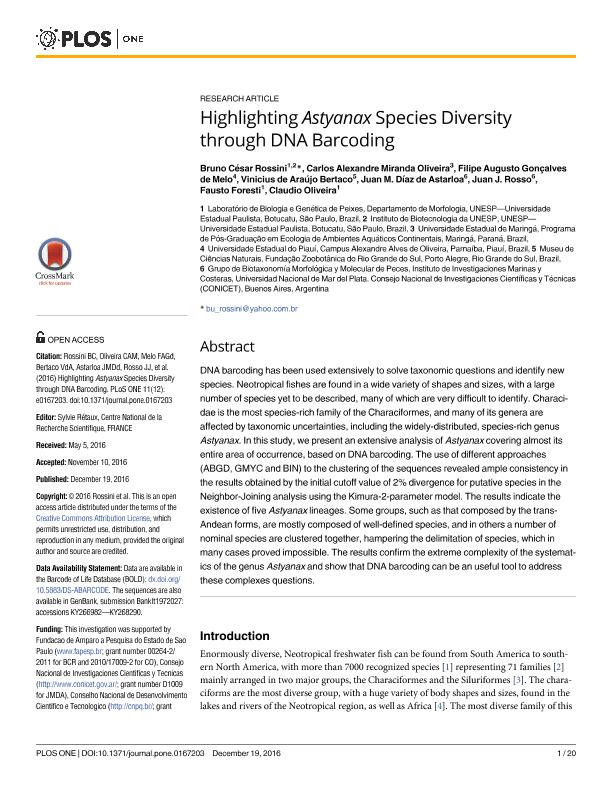Artículo
Highlighting Astyanax species diversity through DNA barcoding
Rossini, Bruno César; Oliveira, Carlos Alexandre Miranda; Melo, Filipe Augusto Gonçalves De; Bertaco, Vinicius De Araú Jo; Díaz de Astarloa, Juan Martín ; Rosso, Juan Jose
; Rosso, Juan Jose ; Foresti, Fausto; Claudio, Oliveira
; Foresti, Fausto; Claudio, Oliveira
 ; Rosso, Juan Jose
; Rosso, Juan Jose ; Foresti, Fausto; Claudio, Oliveira
; Foresti, Fausto; Claudio, Oliveira
Fecha de publicación:
12/2016
Editorial:
Public Library of Science
Revista:
Plos One
e-ISSN:
1932-6203
Idioma:
Inglés
Tipo de recurso:
Artículo publicado
Clasificación temática:
Resumen
DNA barcoding has been used extensively to solve taxonomic questions and identify new species. Neotropical fishes are found in a wide variety of shapes and sizes, with a large number of species yet to be described, many of which are very difficult to identify. Characidae is the most species-rich family of the Characiformes, and many of its genera are affected by taxonomic uncertainties, including the widely-distributed, species-rich genus Astyanax. In this study, we present an extensive analysis of Astyanax covering almost its entire area of occurrence, based on DNA barcoding. The use of different approaches (ABGD, GMYC and BIN) to the clustering of the sequences revealed ample consistency in the results obtained by the initial cutoff value of 2% divergence for putative species in the Neighbor-Joining analysis using the Kimura-2-parameter model. The results indicate the existence of five Astyanax lineages. Some groups, such as that composed by the trans- Andean forms, are mostly composed of well-defined species, and in others a number of nominal species are clustered together, hampering the delimitation of species, which in many cases proved impossible. The results confirm the extreme complexity of the systematics of the genus Astyanax and show that DNA barcoding can be an useful tool to address these complexes questions.
Palabras clave:
Astyanax
,
Diversity
,
Dna Barcoding
,
South America
Archivos asociados
Licencia
Identificadores
Colecciones
Articulos(IIMYC)
Articulos de INSTITUTO DE INVESTIGACIONES MARINAS Y COSTERAS
Articulos de INSTITUTO DE INVESTIGACIONES MARINAS Y COSTERAS
Citación
Rossini, Bruno César; Oliveira, Carlos Alexandre Miranda; Melo, Filipe Augusto Gonçalves De; Bertaco, Vinicius De Araú Jo ; Díaz de Astarloa, Juan Martín; et al.; Highlighting Astyanax species diversity through DNA barcoding; Public Library of Science; Plos One; 11; 12; 12-2016; 1-20; e0167203
Compartir
Altmétricas



